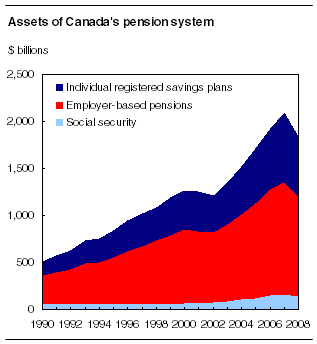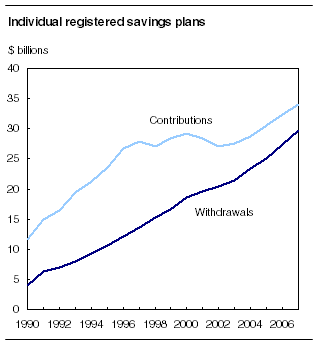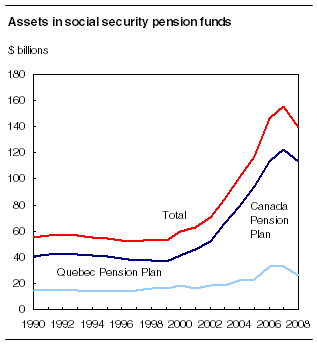Common menu bar links
Study: What does the Pension Satellite Account tell about Canada's pension system?
Archived Content
Information identified as archived is provided for reference, research or recordkeeping purposes. It is not subject to the Government of Canada Web Standards and has not been altered or updated since it was archived. Please "contact us" to request a format other than those available.
There were $1.8 trillion in pension assets in Canada at the end of 2008, down from $2.1 trillion in 2007 but nearly four times greater than the holdings of $0.5 trillion in 1990. Of total pension assets at the end of 2008, social security comprised 7.6%, employer-sponsored plans 58.0% and individual registered savings plans 34.4%.
The $1.0 trillion earned in investment income accounted for most of the increase in pension assets between 1990 and 2007. Contributions of $1.4 trillion narrowly exceeded the $1.3 trillion in withdrawals, for a net inflow of $0.1 trillion. There was a net gain of $0.5 trillion from the revaluation of asset values, which include capital gains and losses, before last year's financial turmoil.

These data are provided separately for three major categories of retirement schemes: government social security plans, employer-sponsored savings plans, and individual registered savings plans.
While social security is the smallest part of Canada's pension system with $140 billion of assets in 2008, it affects the most people. At the end of 2006, 12.3 million people made Canada Pension Plan (CPP) or Quebec Pension Plan (QPP) contributions, 6.3 million contributed to registered retirement savings plans (RRSPs) and 5.7 million had a registered pension plan from their job.
Note to readers
The Pension Satellite Account shows the total wealth position of pensions at the beginning of each year; the inflows of contributions and income earned into these different plans; the outflow of withdrawals; and the revaluation of pension assets during the year to arrive at the wealth position at the end of each year. The stock of pension assets are available to 2008, and the flows to 2007.
Assets held in employer-based pensions and individual registered savings plans rose sharply over the past two decades to $1,064 billion and $631 billion respectively in 2008, driven by higher contributions and revaluations.
Employer-sponsored plans
Assets in employer-sponsored pension plans rose over three-fold from $302 billion in 1990 to $1,064 billion in 2008. Employer-sponsored plans relied on investment income for three-quarters of their growth and revaluations for the rest. Withdrawals exceeded contributions between 1990 and 2007, despite a doubling of contributions since 2002.
The fastest growing segment of trusteed pension plans has been in the public sector. In 1990, public sector plans had assets of $111.1 billion, versus $88.3 billion in the private sector. By 2008, public sector assets had increased five-fold to $555.7 billion, over twice the size of the $248.7 billion in trusteed private sector plans.
The growth of private sector trusteed pension plan assets decelerated markedly in the past decade. After more than doubling from $88.3 billion in assets in 1990 to $196.8 billion in 1999, growth slowed to 26% in the period ending in 2008. The slowdown in asset growth in private sector pension plans reflects smaller revaluations from capital gains since 1999.
Contributions have increased sharply in recent years as private pensions strived to remain fully funded. Contributions rose from between $5 billion and $6 billion a year through most of the 1990s to $11 billion in 2003, partly to make up for the stock market's drop in 2001 and 2002. Since 2003, contributions have risen steadily, to $15 billion a year in 2006 and 2007. Despite the recent increase in contributions to private plans, they remained less than withdrawals.
Individual registered savings plans
Individual registered savings plans grew from $157 billion in 1990 to $631 billion in 2008. They were the only major component of pensions where contributions exceeded withdrawals for the period 1990 through 2007, accounting for about one-fourth of its total asset growth. Investment income earned in individual registered savings plans accounts contributed just under half of growth up to 2007, and revaluations the remaining 27%.
Assets in these plans, especially RRSPs, grew significantly after 1991 when higher contribution limits led to a doubling of contributions between 1990 and 1995.

Contributions to individual registered savings plans rose 20% between 1999 and 2007. An increase in contribution limits starting in 2002 did not provoke the same surge in contributions seen after 1991. Some of the smaller response of contributions may reflect the large gains in revaluations as the stock market rose between 2003 and 2007.
Social Security
There was a sharp increase in social security pension assets from $53 billion in 1999 to $140 billion in 2008, after almost no growth in the 1990s. This was due to a hike in CPP and QPP contribution rates starting in 1997. As well, the CPP was no longer restricted to just investing in government bonds, which boosted its rate of return on average over the past decade.
Withdrawals exceeded contributions into the CPP and QPP on balance by $15 billion between 1990 and 2007. However, all of this net outflow occurred in the 1990s. The net outflow of withdrawals from social security was sharply reversed after the increase in contribution rates, and contributions exceeded withdrawals by nearly $10 billion in recent years.

Definitions, data sources and methods: survey numbers, including related surveys, 2607 and 2609.
The study, "What does the Pension Satellite Account tell about Canada's pension system?", is included in the November 2009 Internet edition of the Canadian Economic Observer, Vol. 22, no. 11 (11-010-X, free), now available from the Publications module of our website.
For more information about the Canadian Economic Observer, click on our banner ad from the Publications module of our website.
For more information, or to enquire about the concepts, methods or data quality of this release, contact Philip Cross (613-951-9162; ceo@statcan.gc.ca), Current Economic Analysis Group.

